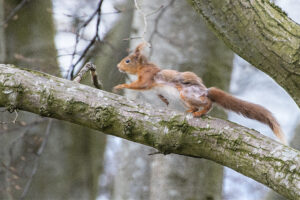It’s that time of year again when we receive a lot of worried enquiries about red squirrels with bald patches from the public, concerned that the squirrels are either sick or injured. As you can see from the image below, they can look very ragged, and some squirrels have large areas of bald skin!
The good news is that if it is running about happily, it is likely that it is simply shedding its winter coat, or moulting. In fact red squirrels have two moults a year, in the spring and the autumn.
Starting at the head and working its way down the body to the base of the tail, the moult can take up to six weeks to complete, and in the autumn the whole process begins again in the opposite direction, from the base of the tail and moving up towards the head.
The glorious fluffy tail and ear tips only moult once a year. The tail begins its moult in June and can take until September to complete. We often get sent photographs of squirrels with one side of its tail looking rather bald and unsightly. The ear tips start to thin out slowly from January, reappearing in September in time for the autumn frosts.
It seems a little precipitous to start moulting at a time of year in Scotland when you can still get hard frosts and heavy snows, and we can only theorise why they moult so early. Dr Mel Tonkin, formerly Project Manager of SSRS was studying wild red squirrels in the 1980’s and didn’t see any evidence of moulting this early. Is it an effect of climate change causing the squirrels’ food sources to grow earlier in the season, or perhaps the increased feeding in people’s gardens of foods that squirrels wouldn’t find in the wild? Whatever the reason, it doesn’t seem to cause red squirrels any difficulties fortunately.
There are other factors that cause balding in squirrels, such as parasite overload (lots of fleas or ticks), mange or allergies, but they are usually accompanied by signs of inflammation and lesions. There is also Squirrel Pox Virus, which is a serious threat to our red squirrels, recognised by lesions around eyes, nose, paws and genitals, often weeping, and localised balding. These squirrels also tend to move very lethargically.
If you see a sick red squirrel and think it may have Squirrelpox please contact us directly, and if you are able to provide a photograph it would help us to assess the likelihood of it having the virus.
If you have squirrels coming to feeders in your garden you can reduce the risk of spreading Squirrelpox and other diseases by regularly cleaning feeders with an antiviral treatment such as Virkon-S.

